IT Write Up Sustainability Research Paper 2022
VerifiedAdded on 2022/09/18
|10
|2030
|26
AI Summary
Contribute Materials
Your contribution can guide someone’s learning journey. Share your
documents today.
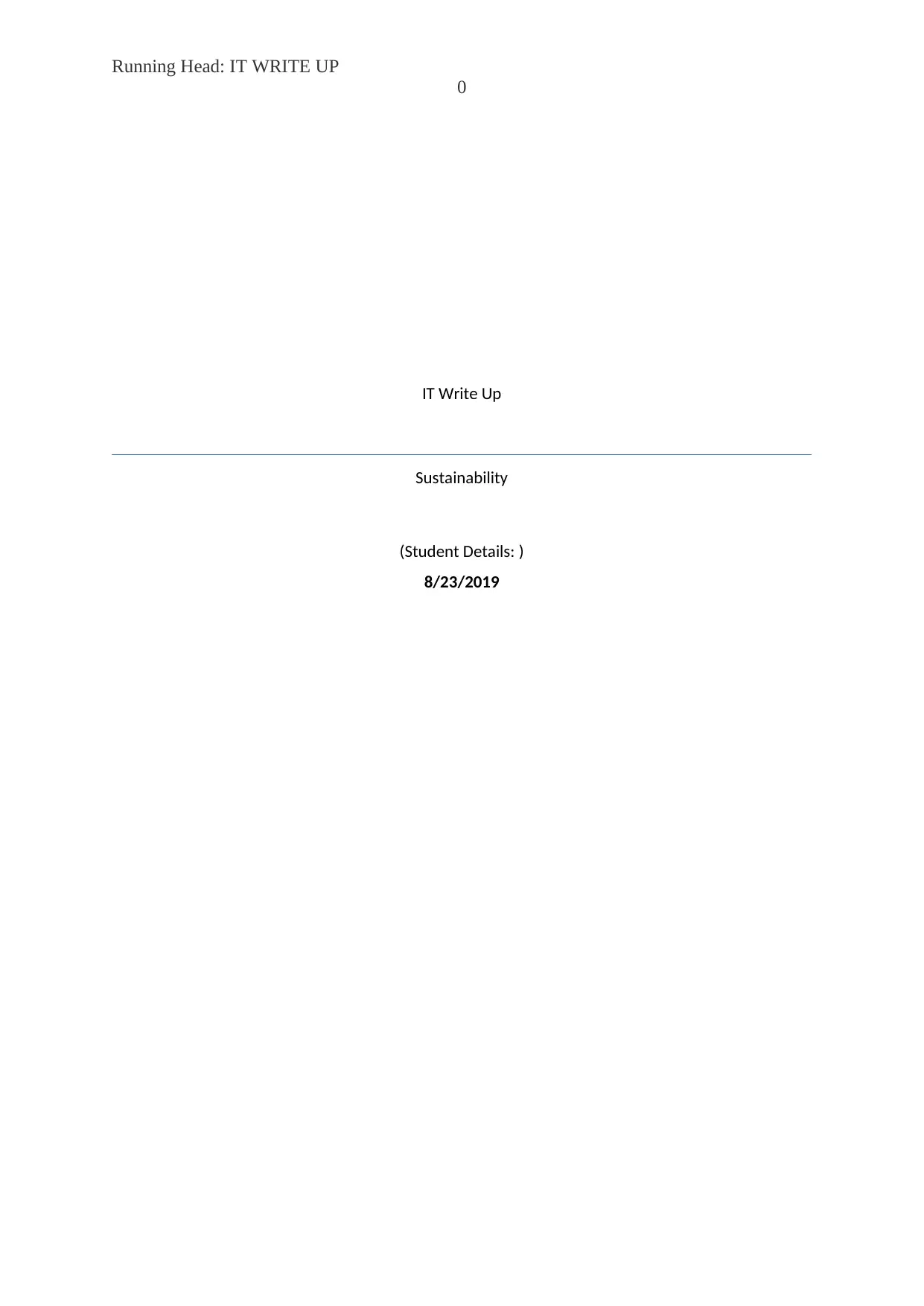
Running Head: IT WRITE UP
0
IT Write Up
Sustainability
(Student Details: )
8/23/2019
0
IT Write Up
Sustainability
(Student Details: )
8/23/2019
Secure Best Marks with AI Grader
Need help grading? Try our AI Grader for instant feedback on your assignments.
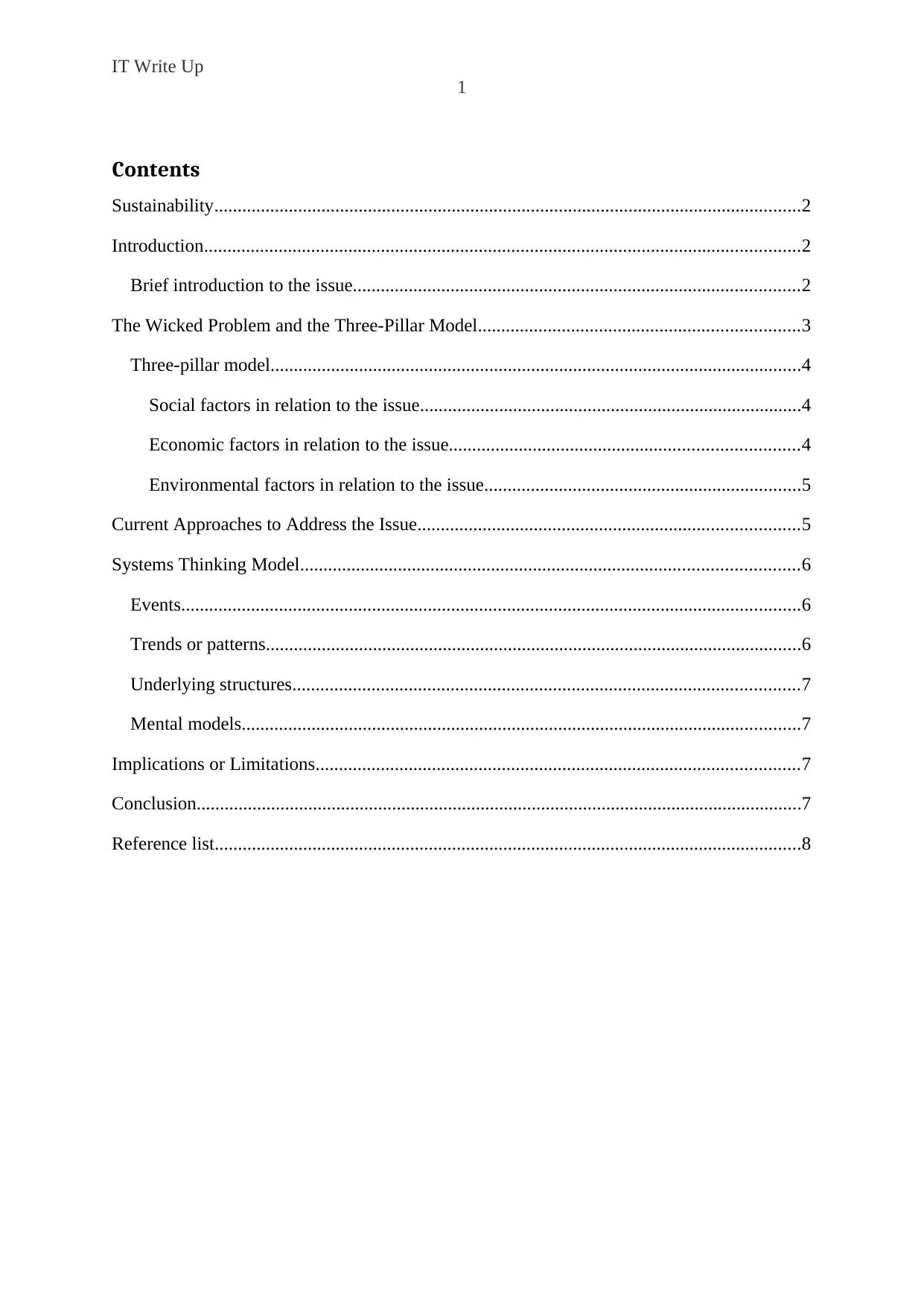
IT Write Up
1
Contents
Sustainability..............................................................................................................................2
Introduction................................................................................................................................2
Brief introduction to the issue................................................................................................2
The Wicked Problem and the Three-Pillar Model.....................................................................3
Three-pillar model..................................................................................................................4
Social factors in relation to the issue..................................................................................4
Economic factors in relation to the issue...........................................................................4
Environmental factors in relation to the issue....................................................................5
Current Approaches to Address the Issue..................................................................................5
Systems Thinking Model...........................................................................................................6
Events.....................................................................................................................................6
Trends or patterns...................................................................................................................6
Underlying structures.............................................................................................................7
Mental models........................................................................................................................7
Implications or Limitations........................................................................................................7
Conclusion..................................................................................................................................7
Reference list..............................................................................................................................8
1
Contents
Sustainability..............................................................................................................................2
Introduction................................................................................................................................2
Brief introduction to the issue................................................................................................2
The Wicked Problem and the Three-Pillar Model.....................................................................3
Three-pillar model..................................................................................................................4
Social factors in relation to the issue..................................................................................4
Economic factors in relation to the issue...........................................................................4
Environmental factors in relation to the issue....................................................................5
Current Approaches to Address the Issue..................................................................................5
Systems Thinking Model...........................................................................................................6
Events.....................................................................................................................................6
Trends or patterns...................................................................................................................6
Underlying structures.............................................................................................................7
Mental models........................................................................................................................7
Implications or Limitations........................................................................................................7
Conclusion..................................................................................................................................7
Reference list..............................................................................................................................8
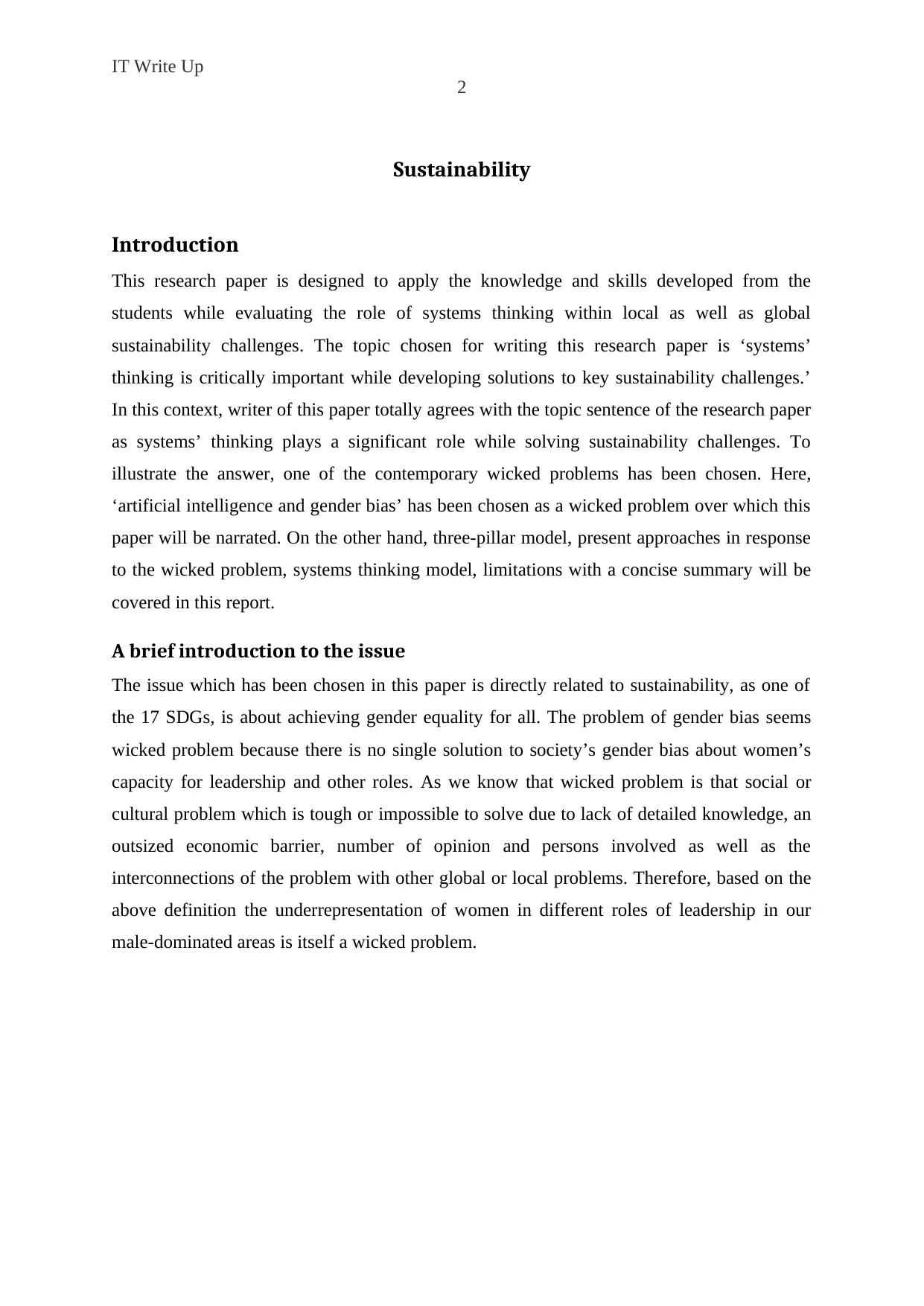
IT Write Up
2
Sustainability
Introduction
This research paper is designed to apply the knowledge and skills developed from the
students while evaluating the role of systems thinking within local as well as global
sustainability challenges. The topic chosen for writing this research paper is ‘systems’
thinking is critically important while developing solutions to key sustainability challenges.’
In this context, writer of this paper totally agrees with the topic sentence of the research paper
as systems’ thinking plays a significant role while solving sustainability challenges. To
illustrate the answer, one of the contemporary wicked problems has been chosen. Here,
‘artificial intelligence and gender bias’ has been chosen as a wicked problem over which this
paper will be narrated. On the other hand, three-pillar model, present approaches in response
to the wicked problem, systems thinking model, limitations with a concise summary will be
covered in this report.
A brief introduction to the issue
The issue which has been chosen in this paper is directly related to sustainability, as one of
the 17 SDGs, is about achieving gender equality for all. The problem of gender bias seems
wicked problem because there is no single solution to society’s gender bias about women’s
capacity for leadership and other roles. As we know that wicked problem is that social or
cultural problem which is tough or impossible to solve due to lack of detailed knowledge, an
outsized economic barrier, number of opinion and persons involved as well as the
interconnections of the problem with other global or local problems. Therefore, based on the
above definition the underrepresentation of women in different roles of leadership in our
male-dominated areas is itself a wicked problem.
2
Sustainability
Introduction
This research paper is designed to apply the knowledge and skills developed from the
students while evaluating the role of systems thinking within local as well as global
sustainability challenges. The topic chosen for writing this research paper is ‘systems’
thinking is critically important while developing solutions to key sustainability challenges.’
In this context, writer of this paper totally agrees with the topic sentence of the research paper
as systems’ thinking plays a significant role while solving sustainability challenges. To
illustrate the answer, one of the contemporary wicked problems has been chosen. Here,
‘artificial intelligence and gender bias’ has been chosen as a wicked problem over which this
paper will be narrated. On the other hand, three-pillar model, present approaches in response
to the wicked problem, systems thinking model, limitations with a concise summary will be
covered in this report.
A brief introduction to the issue
The issue which has been chosen in this paper is directly related to sustainability, as one of
the 17 SDGs, is about achieving gender equality for all. The problem of gender bias seems
wicked problem because there is no single solution to society’s gender bias about women’s
capacity for leadership and other roles. As we know that wicked problem is that social or
cultural problem which is tough or impossible to solve due to lack of detailed knowledge, an
outsized economic barrier, number of opinion and persons involved as well as the
interconnections of the problem with other global or local problems. Therefore, based on the
above definition the underrepresentation of women in different roles of leadership in our
male-dominated areas is itself a wicked problem.
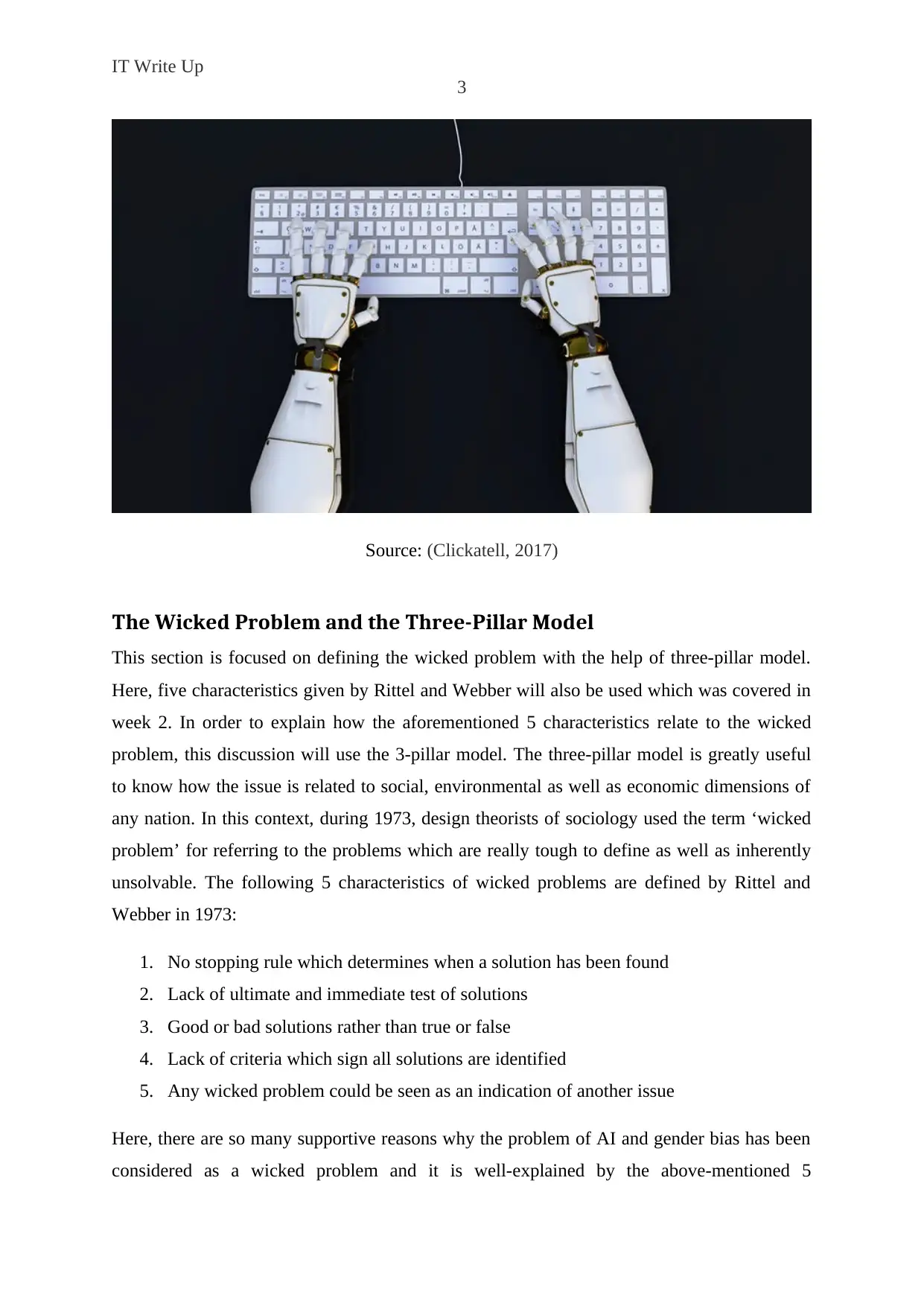
IT Write Up
3
Source: (Clickatell, 2017)
The Wicked Problem and the Three-Pillar Model
This section is focused on defining the wicked problem with the help of three-pillar model.
Here, five characteristics given by Rittel and Webber will also be used which was covered in
week 2. In order to explain how the aforementioned 5 characteristics relate to the wicked
problem, this discussion will use the 3-pillar model. The three-pillar model is greatly useful
to know how the issue is related to social, environmental as well as economic dimensions of
any nation. In this context, during 1973, design theorists of sociology used the term ‘wicked
problem’ for referring to the problems which are really tough to define as well as inherently
unsolvable. The following 5 characteristics of wicked problems are defined by Rittel and
Webber in 1973:
1. No stopping rule which determines when a solution has been found
2. Lack of ultimate and immediate test of solutions
3. Good or bad solutions rather than true or false
4. Lack of criteria which sign all solutions are identified
5. Any wicked problem could be seen as an indication of another issue
Here, there are so many supportive reasons why the problem of AI and gender bias has been
considered as a wicked problem and it is well-explained by the above-mentioned 5
3
Source: (Clickatell, 2017)
The Wicked Problem and the Three-Pillar Model
This section is focused on defining the wicked problem with the help of three-pillar model.
Here, five characteristics given by Rittel and Webber will also be used which was covered in
week 2. In order to explain how the aforementioned 5 characteristics relate to the wicked
problem, this discussion will use the 3-pillar model. The three-pillar model is greatly useful
to know how the issue is related to social, environmental as well as economic dimensions of
any nation. In this context, during 1973, design theorists of sociology used the term ‘wicked
problem’ for referring to the problems which are really tough to define as well as inherently
unsolvable. The following 5 characteristics of wicked problems are defined by Rittel and
Webber in 1973:
1. No stopping rule which determines when a solution has been found
2. Lack of ultimate and immediate test of solutions
3. Good or bad solutions rather than true or false
4. Lack of criteria which sign all solutions are identified
5. Any wicked problem could be seen as an indication of another issue
Here, there are so many supportive reasons why the problem of AI and gender bias has been
considered as a wicked problem and it is well-explained by the above-mentioned 5
Secure Best Marks with AI Grader
Need help grading? Try our AI Grader for instant feedback on your assignments.
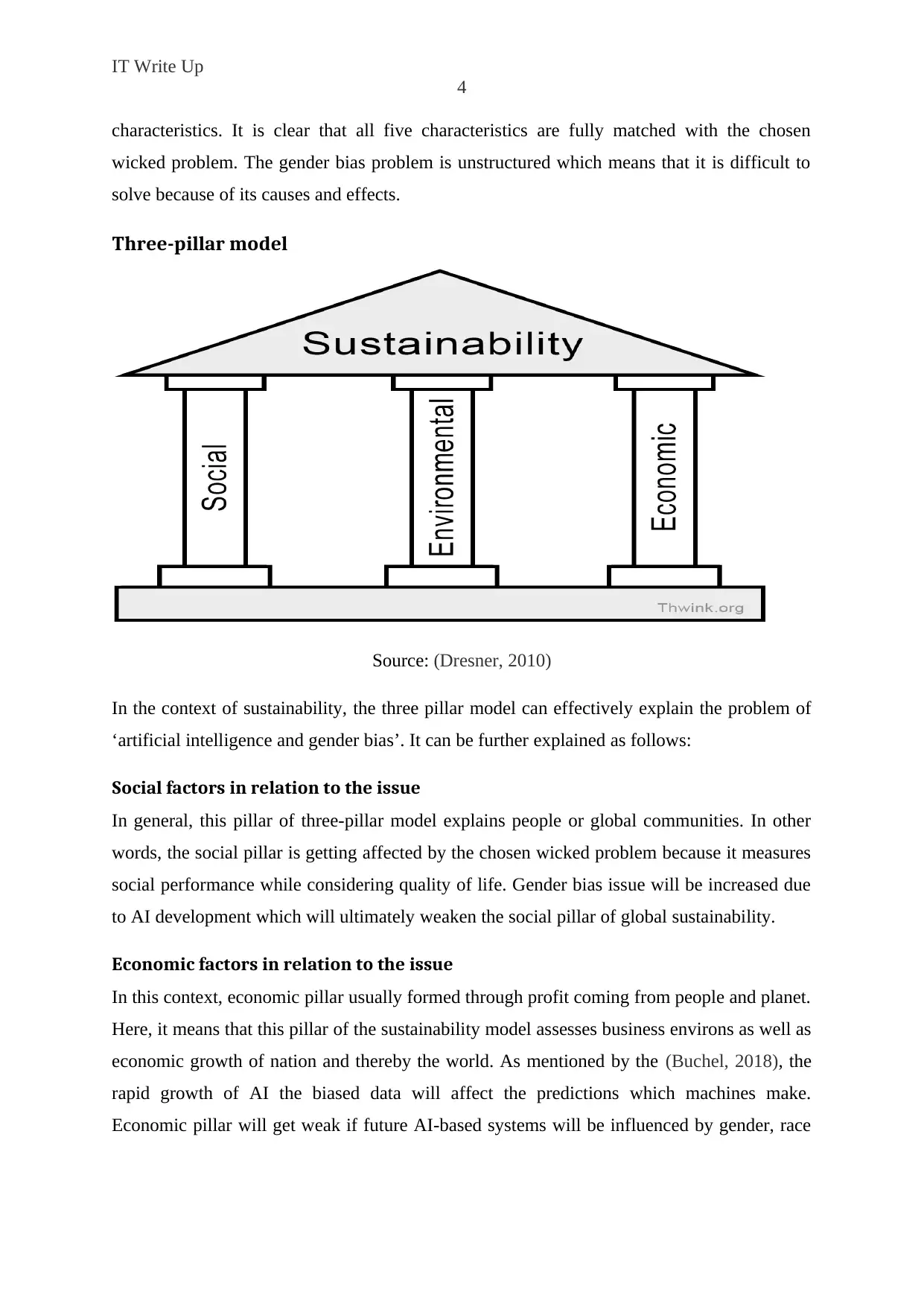
IT Write Up
4
characteristics. It is clear that all five characteristics are fully matched with the chosen
wicked problem. The gender bias problem is unstructured which means that it is difficult to
solve because of its causes and effects.
Three-pillar model
Source: (Dresner, 2010)
In the context of sustainability, the three pillar model can effectively explain the problem of
‘artificial intelligence and gender bias’. It can be further explained as follows:
Social factors in relation to the issue
In general, this pillar of three-pillar model explains people or global communities. In other
words, the social pillar is getting affected by the chosen wicked problem because it measures
social performance while considering quality of life. Gender bias issue will be increased due
to AI development which will ultimately weaken the social pillar of global sustainability.
Economic factors in relation to the issue
In this context, economic pillar usually formed through profit coming from people and planet.
Here, it means that this pillar of the sustainability model assesses business environs as well as
economic growth of nation and thereby the world. As mentioned by the (Buchel, 2018), the
rapid growth of AI the biased data will affect the predictions which machines make.
Economic pillar will get weak if future AI-based systems will be influenced by gender, race
4
characteristics. It is clear that all five characteristics are fully matched with the chosen
wicked problem. The gender bias problem is unstructured which means that it is difficult to
solve because of its causes and effects.
Three-pillar model
Source: (Dresner, 2010)
In the context of sustainability, the three pillar model can effectively explain the problem of
‘artificial intelligence and gender bias’. It can be further explained as follows:
Social factors in relation to the issue
In general, this pillar of three-pillar model explains people or global communities. In other
words, the social pillar is getting affected by the chosen wicked problem because it measures
social performance while considering quality of life. Gender bias issue will be increased due
to AI development which will ultimately weaken the social pillar of global sustainability.
Economic factors in relation to the issue
In this context, economic pillar usually formed through profit coming from people and planet.
Here, it means that this pillar of the sustainability model assesses business environs as well as
economic growth of nation and thereby the world. As mentioned by the (Buchel, 2018), the
rapid growth of AI the biased data will affect the predictions which machines make.
Economic pillar will get weak if future AI-based systems will be influenced by gender, race
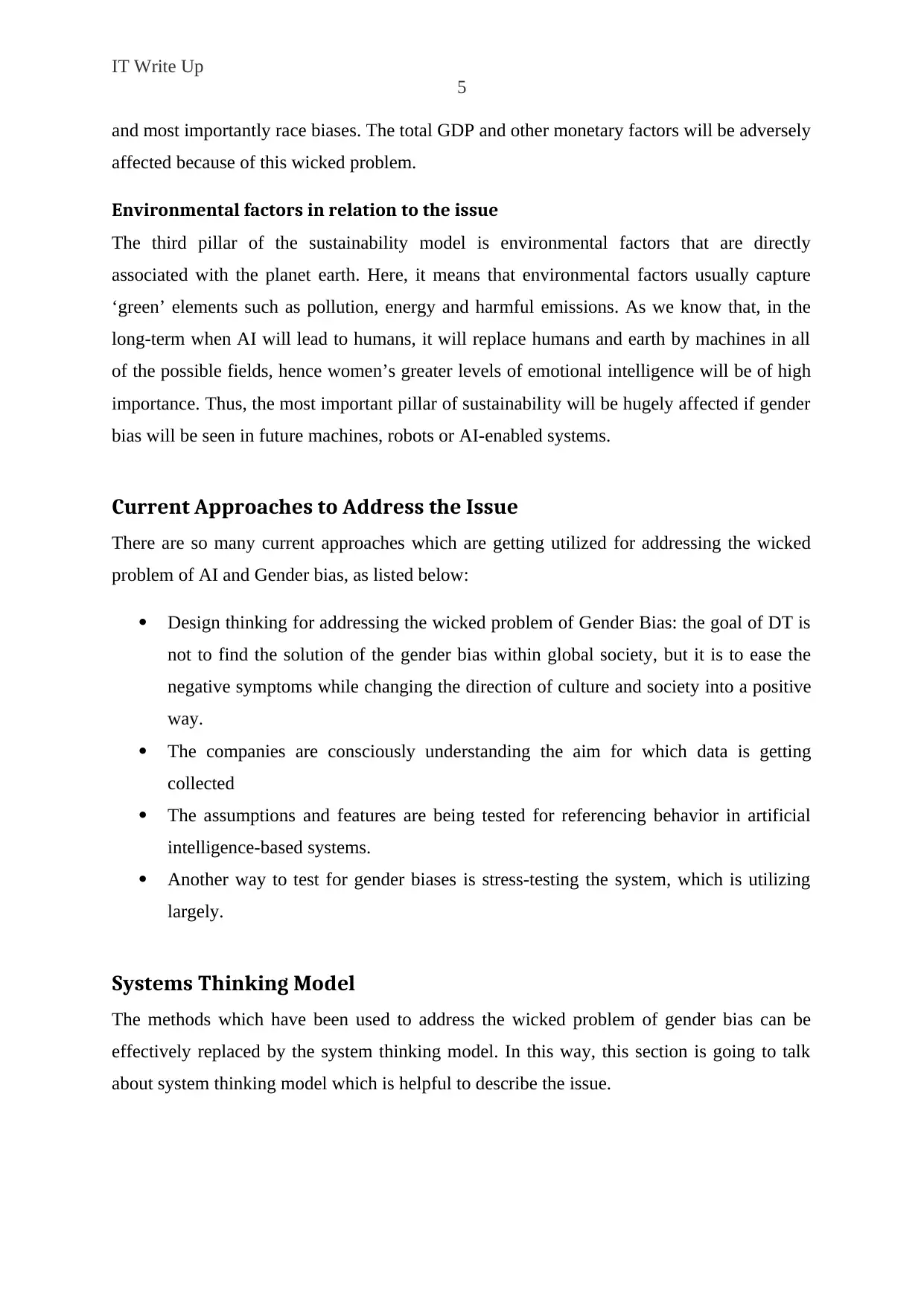
IT Write Up
5
and most importantly race biases. The total GDP and other monetary factors will be adversely
affected because of this wicked problem.
Environmental factors in relation to the issue
The third pillar of the sustainability model is environmental factors that are directly
associated with the planet earth. Here, it means that environmental factors usually capture
‘green’ elements such as pollution, energy and harmful emissions. As we know that, in the
long-term when AI will lead to humans, it will replace humans and earth by machines in all
of the possible fields, hence women’s greater levels of emotional intelligence will be of high
importance. Thus, the most important pillar of sustainability will be hugely affected if gender
bias will be seen in future machines, robots or AI-enabled systems.
Current Approaches to Address the Issue
There are so many current approaches which are getting utilized for addressing the wicked
problem of AI and Gender bias, as listed below:
Design thinking for addressing the wicked problem of Gender Bias: the goal of DT is
not to find the solution of the gender bias within global society, but it is to ease the
negative symptoms while changing the direction of culture and society into a positive
way.
The companies are consciously understanding the aim for which data is getting
collected
The assumptions and features are being tested for referencing behavior in artificial
intelligence-based systems.
Another way to test for gender biases is stress-testing the system, which is utilizing
largely.
Systems Thinking Model
The methods which have been used to address the wicked problem of gender bias can be
effectively replaced by the system thinking model. In this way, this section is going to talk
about system thinking model which is helpful to describe the issue.
5
and most importantly race biases. The total GDP and other monetary factors will be adversely
affected because of this wicked problem.
Environmental factors in relation to the issue
The third pillar of the sustainability model is environmental factors that are directly
associated with the planet earth. Here, it means that environmental factors usually capture
‘green’ elements such as pollution, energy and harmful emissions. As we know that, in the
long-term when AI will lead to humans, it will replace humans and earth by machines in all
of the possible fields, hence women’s greater levels of emotional intelligence will be of high
importance. Thus, the most important pillar of sustainability will be hugely affected if gender
bias will be seen in future machines, robots or AI-enabled systems.
Current Approaches to Address the Issue
There are so many current approaches which are getting utilized for addressing the wicked
problem of AI and Gender bias, as listed below:
Design thinking for addressing the wicked problem of Gender Bias: the goal of DT is
not to find the solution of the gender bias within global society, but it is to ease the
negative symptoms while changing the direction of culture and society into a positive
way.
The companies are consciously understanding the aim for which data is getting
collected
The assumptions and features are being tested for referencing behavior in artificial
intelligence-based systems.
Another way to test for gender biases is stress-testing the system, which is utilizing
largely.
Systems Thinking Model
The methods which have been used to address the wicked problem of gender bias can be
effectively replaced by the system thinking model. In this way, this section is going to talk
about system thinking model which is helpful to describe the issue.
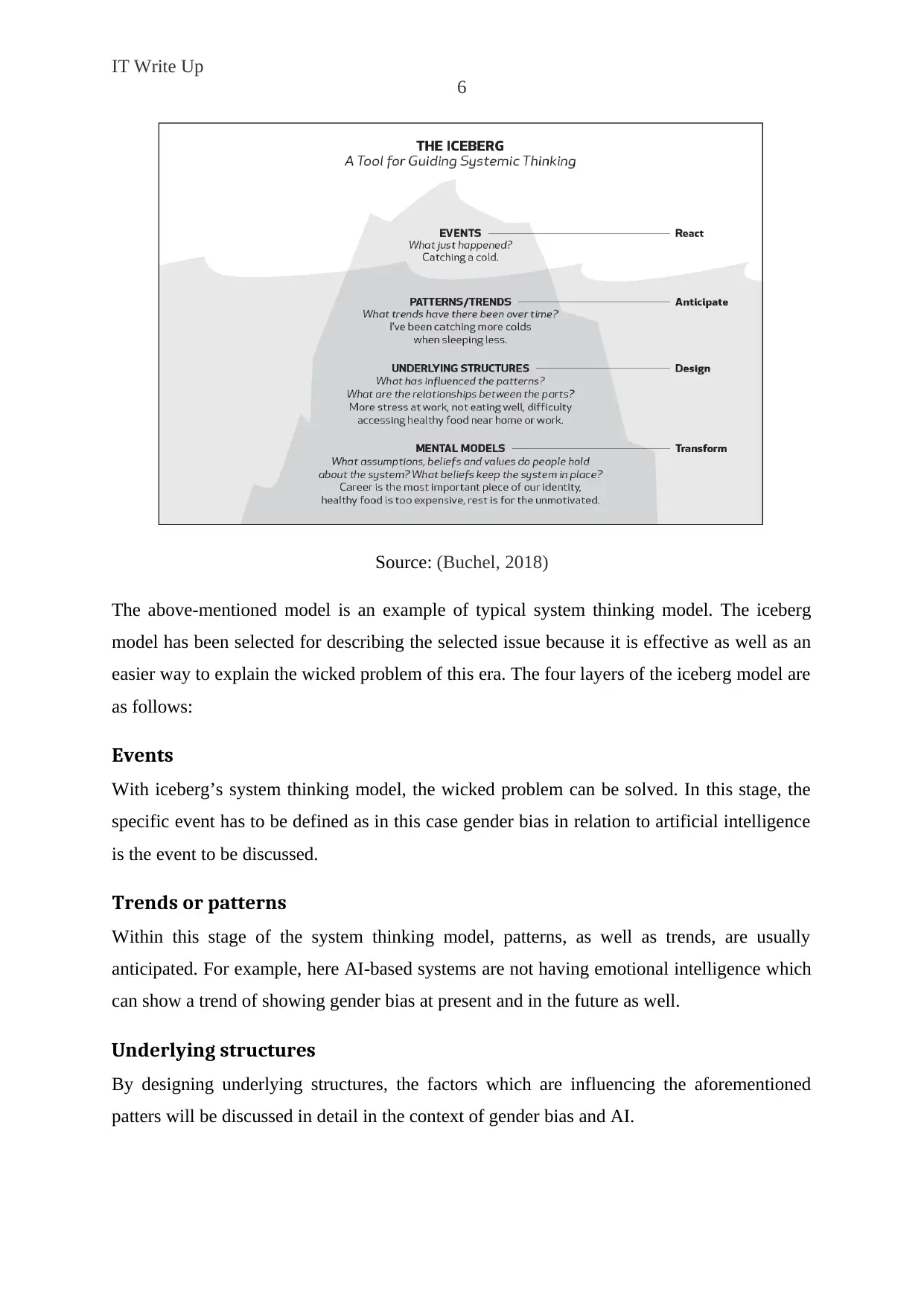
IT Write Up
6
Source: (Buchel, 2018)
The above-mentioned model is an example of typical system thinking model. The iceberg
model has been selected for describing the selected issue because it is effective as well as an
easier way to explain the wicked problem of this era. The four layers of the iceberg model are
as follows:
Events
With iceberg’s system thinking model, the wicked problem can be solved. In this stage, the
specific event has to be defined as in this case gender bias in relation to artificial intelligence
is the event to be discussed.
Trends or patterns
Within this stage of the system thinking model, patterns, as well as trends, are usually
anticipated. For example, here AI-based systems are not having emotional intelligence which
can show a trend of showing gender bias at present and in the future as well.
Underlying structures
By designing underlying structures, the factors which are influencing the aforementioned
patters will be discussed in detail in the context of gender bias and AI.
6
Source: (Buchel, 2018)
The above-mentioned model is an example of typical system thinking model. The iceberg
model has been selected for describing the selected issue because it is effective as well as an
easier way to explain the wicked problem of this era. The four layers of the iceberg model are
as follows:
Events
With iceberg’s system thinking model, the wicked problem can be solved. In this stage, the
specific event has to be defined as in this case gender bias in relation to artificial intelligence
is the event to be discussed.
Trends or patterns
Within this stage of the system thinking model, patterns, as well as trends, are usually
anticipated. For example, here AI-based systems are not having emotional intelligence which
can show a trend of showing gender bias at present and in the future as well.
Underlying structures
By designing underlying structures, the factors which are influencing the aforementioned
patters will be discussed in detail in the context of gender bias and AI.
Paraphrase This Document
Need a fresh take? Get an instant paraphrase of this document with our AI Paraphraser
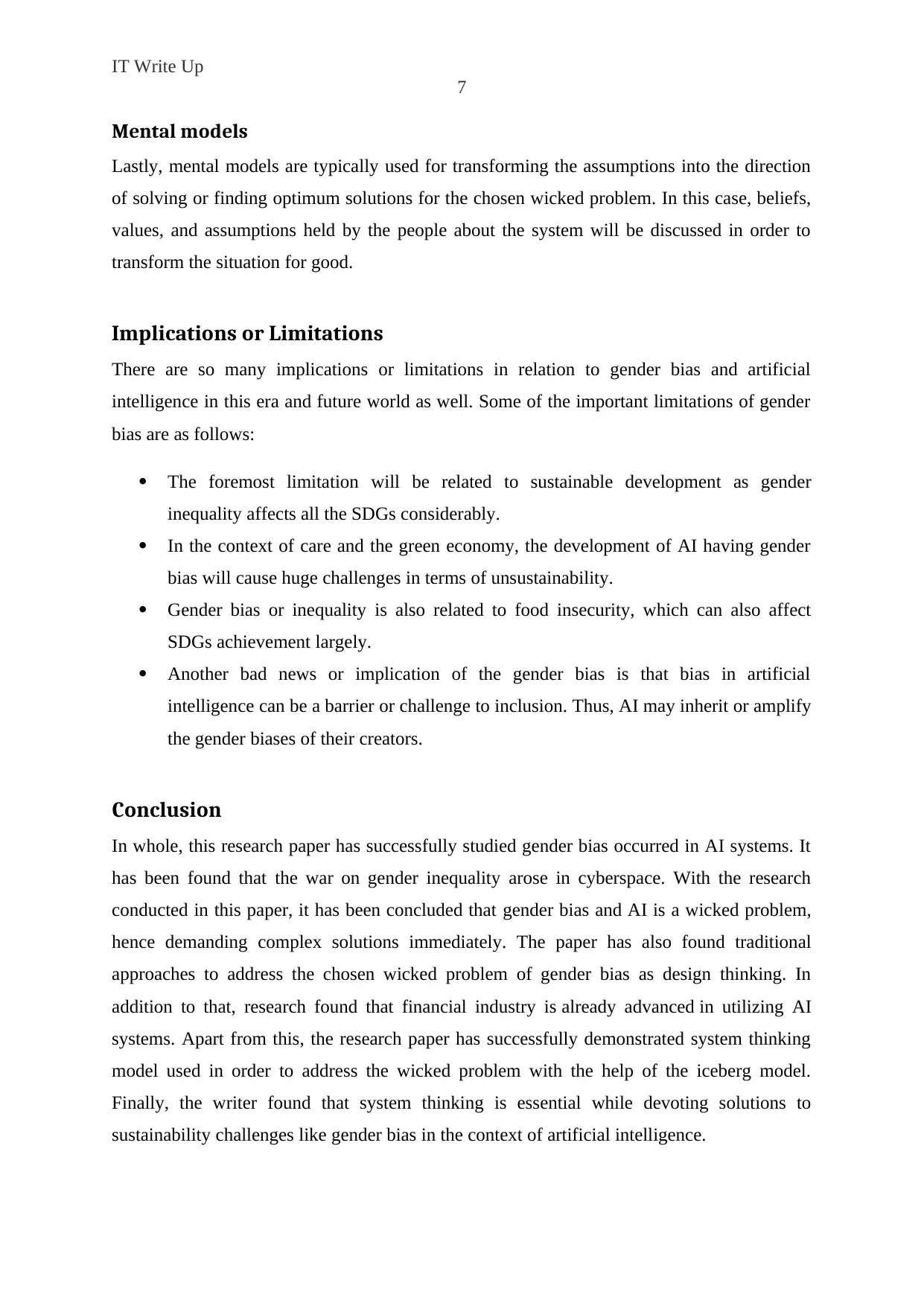
IT Write Up
7
Mental models
Lastly, mental models are typically used for transforming the assumptions into the direction
of solving or finding optimum solutions for the chosen wicked problem. In this case, beliefs,
values, and assumptions held by the people about the system will be discussed in order to
transform the situation for good.
Implications or Limitations
There are so many implications or limitations in relation to gender bias and artificial
intelligence in this era and future world as well. Some of the important limitations of gender
bias are as follows:
The foremost limitation will be related to sustainable development as gender
inequality affects all the SDGs considerably.
In the context of care and the green economy, the development of AI having gender
bias will cause huge challenges in terms of unsustainability.
Gender bias or inequality is also related to food insecurity, which can also affect
SDGs achievement largely.
Another bad news or implication of the gender bias is that bias in artificial
intelligence can be a barrier or challenge to inclusion. Thus, AI may inherit or amplify
the gender biases of their creators.
Conclusion
In whole, this research paper has successfully studied gender bias occurred in AI systems. It
has been found that the war on gender inequality arose in cyberspace. With the research
conducted in this paper, it has been concluded that gender bias and AI is a wicked problem,
hence demanding complex solutions immediately. The paper has also found traditional
approaches to address the chosen wicked problem of gender bias as design thinking. In
addition to that, research found that financial industry is already advanced in utilizing AI
systems. Apart from this, the research paper has successfully demonstrated system thinking
model used in order to address the wicked problem with the help of the iceberg model.
Finally, the writer found that system thinking is essential while devoting solutions to
sustainability challenges like gender bias in the context of artificial intelligence.
7
Mental models
Lastly, mental models are typically used for transforming the assumptions into the direction
of solving or finding optimum solutions for the chosen wicked problem. In this case, beliefs,
values, and assumptions held by the people about the system will be discussed in order to
transform the situation for good.
Implications or Limitations
There are so many implications or limitations in relation to gender bias and artificial
intelligence in this era and future world as well. Some of the important limitations of gender
bias are as follows:
The foremost limitation will be related to sustainable development as gender
inequality affects all the SDGs considerably.
In the context of care and the green economy, the development of AI having gender
bias will cause huge challenges in terms of unsustainability.
Gender bias or inequality is also related to food insecurity, which can also affect
SDGs achievement largely.
Another bad news or implication of the gender bias is that bias in artificial
intelligence can be a barrier or challenge to inclusion. Thus, AI may inherit or amplify
the gender biases of their creators.
Conclusion
In whole, this research paper has successfully studied gender bias occurred in AI systems. It
has been found that the war on gender inequality arose in cyberspace. With the research
conducted in this paper, it has been concluded that gender bias and AI is a wicked problem,
hence demanding complex solutions immediately. The paper has also found traditional
approaches to address the chosen wicked problem of gender bias as design thinking. In
addition to that, research found that financial industry is already advanced in utilizing AI
systems. Apart from this, the research paper has successfully demonstrated system thinking
model used in order to address the wicked problem with the help of the iceberg model.
Finally, the writer found that system thinking is essential while devoting solutions to
sustainability challenges like gender bias in the context of artificial intelligence.
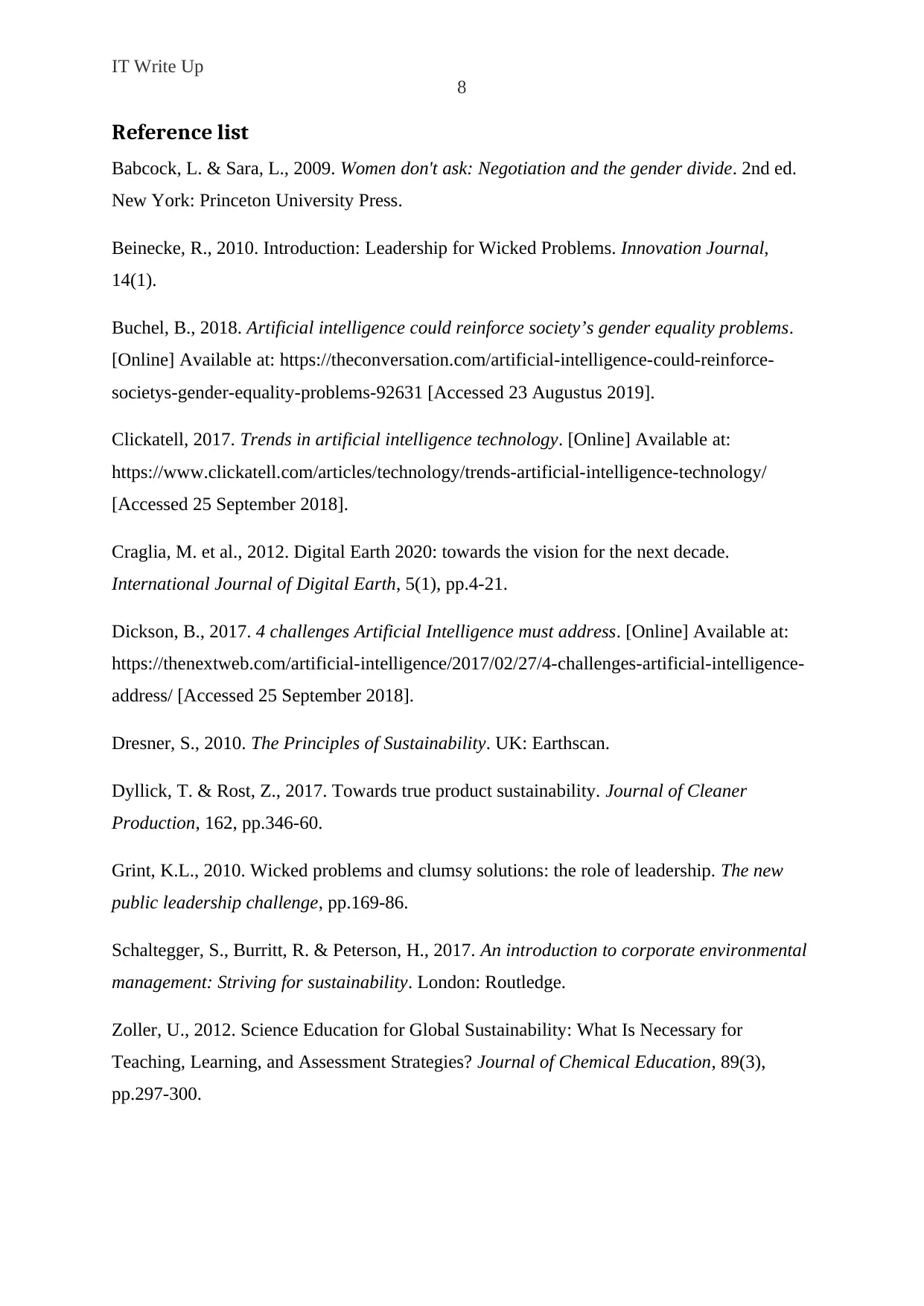
IT Write Up
8
Reference list
Babcock, L. & Sara, L., 2009. Women don't ask: Negotiation and the gender divide. 2nd ed.
New York: Princeton University Press.
Beinecke, R., 2010. Introduction: Leadership for Wicked Problems. Innovation Journal,
14(1).
Buchel, B., 2018. Artificial intelligence could reinforce society’s gender equality problems.
[Online] Available at: https://theconversation.com/artificial-intelligence-could-reinforce-
societys-gender-equality-problems-92631 [Accessed 23 Augustus 2019].
Clickatell, 2017. Trends in artificial intelligence technology. [Online] Available at:
https://www.clickatell.com/articles/technology/trends-artificial-intelligence-technology/
[Accessed 25 September 2018].
Craglia, M. et al., 2012. Digital Earth 2020: towards the vision for the next decade.
International Journal of Digital Earth, 5(1), pp.4-21.
Dickson, B., 2017. 4 challenges Artificial Intelligence must address. [Online] Available at:
https://thenextweb.com/artificial-intelligence/2017/02/27/4-challenges-artificial-intelligence-
address/ [Accessed 25 September 2018].
Dresner, S., 2010. The Principles of Sustainability. UK: Earthscan.
Dyllick, T. & Rost, Z., 2017. Towards true product sustainability. Journal of Cleaner
Production, 162, pp.346-60.
Grint, K.L., 2010. Wicked problems and clumsy solutions: the role of leadership. The new
public leadership challenge, pp.169-86.
Schaltegger, S., Burritt, R. & Peterson, H., 2017. An introduction to corporate environmental
management: Striving for sustainability. London: Routledge.
Zoller, U., 2012. Science Education for Global Sustainability: What Is Necessary for
Teaching, Learning, and Assessment Strategies? Journal of Chemical Education, 89(3),
pp.297-300.
8
Reference list
Babcock, L. & Sara, L., 2009. Women don't ask: Negotiation and the gender divide. 2nd ed.
New York: Princeton University Press.
Beinecke, R., 2010. Introduction: Leadership for Wicked Problems. Innovation Journal,
14(1).
Buchel, B., 2018. Artificial intelligence could reinforce society’s gender equality problems.
[Online] Available at: https://theconversation.com/artificial-intelligence-could-reinforce-
societys-gender-equality-problems-92631 [Accessed 23 Augustus 2019].
Clickatell, 2017. Trends in artificial intelligence technology. [Online] Available at:
https://www.clickatell.com/articles/technology/trends-artificial-intelligence-technology/
[Accessed 25 September 2018].
Craglia, M. et al., 2012. Digital Earth 2020: towards the vision for the next decade.
International Journal of Digital Earth, 5(1), pp.4-21.
Dickson, B., 2017. 4 challenges Artificial Intelligence must address. [Online] Available at:
https://thenextweb.com/artificial-intelligence/2017/02/27/4-challenges-artificial-intelligence-
address/ [Accessed 25 September 2018].
Dresner, S., 2010. The Principles of Sustainability. UK: Earthscan.
Dyllick, T. & Rost, Z., 2017. Towards true product sustainability. Journal of Cleaner
Production, 162, pp.346-60.
Grint, K.L., 2010. Wicked problems and clumsy solutions: the role of leadership. The new
public leadership challenge, pp.169-86.
Schaltegger, S., Burritt, R. & Peterson, H., 2017. An introduction to corporate environmental
management: Striving for sustainability. London: Routledge.
Zoller, U., 2012. Science Education for Global Sustainability: What Is Necessary for
Teaching, Learning, and Assessment Strategies? Journal of Chemical Education, 89(3),
pp.297-300.

IT Write Up
9
9
1 out of 10
Related Documents
Your All-in-One AI-Powered Toolkit for Academic Success.
+13062052269
info@desklib.com
Available 24*7 on WhatsApp / Email
![[object Object]](/_next/static/media/star-bottom.7253800d.svg)
Unlock your academic potential
© 2024 | Zucol Services PVT LTD | All rights reserved.




